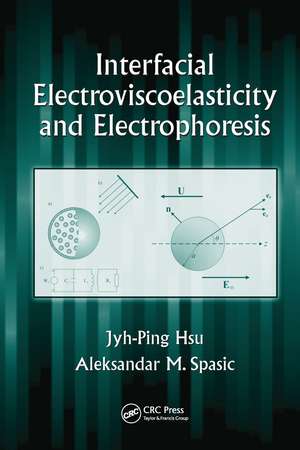Interfacial Electroviscoelasticity and Electrophoresis
Autor Jyh-Ping Hsu, Aleksandar M. Spasicen Limba Engleză Hardback – 17 mar 2010
Introducing more profound and in-depth treatises related to the liquid-liquid finely dispersed systems (i.e., emulsions and double emulsions), this book describes a new theory developed through the authors’ work. These findings are likely to impact other research and applications in a wide array of other fields, considering that the modeling of liquid-liquid interfaces is key to numerous chemical manufacturing processes, including those used for emulsions, suspensions, nanopowders, foams, biocolloids, and plasmas. The authors cover phenomena at the micro, nano, and atto-scales, and their techniques, theory, and supporting data will be of particular interest to nanoscientists, especially with regard to the breaking of emulsions.
This groundbreaking book:
- Takes an interdisciplinary approach to elucidate the momentum transfer and electron transfer phenomena
- Covers less classical chemical engineering insight and modern molecular and atomic engineering
- Reviews basic theory of electrokinetics, using the electrophoresis of rigid particles as an example
| Toate formatele și edițiile | Preț | Express |
|---|---|---|
| Paperback (1) | 427.84 lei 6-8 săpt. | |
| CRC Press – 14 iun 2017 | 427.84 lei 6-8 săpt. | |
| Hardback (1) | 1097.39 lei 6-8 săpt. | |
| CRC Press – 17 mar 2010 | 1097.39 lei 6-8 săpt. |
Preț: 1097.39 lei
Preț vechi: 1554.49 lei
-29% Nou
Puncte Express: 1646
Preț estimativ în valută:
210.05€ • 228.24$ • 176.56£
210.05€ • 228.24$ • 176.56£
Carte tipărită la comandă
Livrare economică 21 aprilie-05 mai
Preluare comenzi: 021 569.72.76
Specificații
ISBN-13: 9781439803523
ISBN-10: 1439803528
Pagini: 194
Ilustrații: 46 b/w images, 5 tables and 401
Dimensiuni: 156 x 234 x 14 mm
Greutate: 0.41 kg
Ediția:New.
Editura: CRC Press
Colecția CRC Press
ISBN-10: 1439803528
Pagini: 194
Ilustrații: 46 b/w images, 5 tables and 401
Dimensiuni: 156 x 234 x 14 mm
Greutate: 0.41 kg
Ediția:New.
Editura: CRC Press
Colecția CRC Press
Cuprins
Introduction. Classification of Finely Dispersed Systems. General. Historical Review and Motivation. Particular. Theory of Electroviscoelasticity. Appendix. Experimental. Experimental. Conclusions. Implications. Electrophoresis. Introduction. General Governing Equations. Boundary Conditions. Perturbation Approach. Boundary Effects. Solution Procedure. Concluding Remarks. List of Symbols. References. Author Index. Subject Index.
Notă biografică
Jyh-Ping Hsu, Aleksandar M. Spasic
Descriere
Not only is this the first text devoted to electroviscoelasticity, but it also describes a new theory developed through the authors’ research. This theory is likely to impact other research and applications as the modeling of liquid-liquid interfaces is key to numerous chemical manufacturing processes including those for emulsions, suspensions, nanopowders, foams, biocoloids, and plasmas. As the authors cover phenomena at the micro, nano, and atto-scales, their techniques as well as their data will be of particular interest to nanoscientists. The authors provide substantial data to support their theory and consider its implications especially with regard to the breaking of emulsions.






